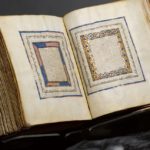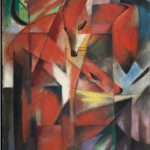
Tallinn, Estonia – The Kumu Art Museum in Tallinn, Estonia, is showing the work of two of Estonia’s best known modern painters in the exhibition “Alone in the City: Ludmilla Siim and Jüri Palm” from April 29th until August 28th. In this exhibition, two original artists, whose paintings from the 1970s speak of the various ways of perceiving urban environments, enter into a dialogue. Although both artists are from the same generation, each saw the urban milieu in different and idiosyncratic ways, possibly reflecting their different situuations, Jüri Palm remained in Estonia, while Ludmilla Siim moved to Finland in the mid-1970s. When shown together, they create a fascinating conversation about the realities of city life both in Estonia and Finland.
The early works of Ludmilla Siim can be described as pre-hyperrealist, as these were the first works in Estonia that showed desolate urban interiors and cityscapes with geometrically regulated space painted with photographic exactitude. The fashionably dressed young figures seem totally out of place in the rooms drawn onto the canvas that follow strict rules of central perspective. In 1977 Ludmilla Siim moved to Finland. Influenced by local trends, her painting style became more abstract. However in her paintings from the 1990s there is a visibly nostalgic return to figurative painting. In terms of new technical solutions, she began using plexiglass in order to accentuate forms and shadows. The artist also made several sculptures using the same material.
Art historian Eha Komissarov has said about her: “Ludmilla Siim is the grand lady of recent Estonian art, a powerful and mysterious person whose artistic work from the 1960s and 1970s holds the art history of the era in its leash”. The painting “Air Space”, with its geometrically structured room, reflects quite directly Siim’s artistic methods from the 1970s. Her long-time dream to produce a different kind of reality with her images, is further intensified by tragic events that took place in her personal life (the death of her husband caused by the negligence of hospital staff after a successful operation). The souls that are cut away from this world by the screens, float in the harsh light of the bleak operating theatre, ready to dissolve into the air space.

 Jüri Palm was born in Tallinn in 1937 and graduated from the Estonian State Art Institute, where he initially studied ceramics and then graphics. In 1963, the year he graduated, his works appeared in his first exhibition. Jüri Palm started his career as an extremely promising graphic artist, but by 1966 committed himself exclusively to painting. He was awarded the BC Iron Award in both 1977 and 1988. He stood firmly at the forefront of Estonian painting in the 1970s and 1980s, exhibiting at the Vilnius maalitriennaalil in 1972, 1975. and 1987. In 1977 he had a retrospective at the Tallinn and Tartu Art Museum. Jüri Palm has always insisted on speaking to the art of the social, unusual in the context of Estonian art. Palm’s works have been exhibited throughout the former Soviet Union, Scandinavia and the US.
Jüri Palm was born in Tallinn in 1937 and graduated from the Estonian State Art Institute, where he initially studied ceramics and then graphics. In 1963, the year he graduated, his works appeared in his first exhibition. Jüri Palm started his career as an extremely promising graphic artist, but by 1966 committed himself exclusively to painting. He was awarded the BC Iron Award in both 1977 and 1988. He stood firmly at the forefront of Estonian painting in the 1970s and 1980s, exhibiting at the Vilnius maalitriennaalil in 1972, 1975. and 1987. In 1977 he had a retrospective at the Tallinn and Tartu Art Museum. Jüri Palm has always insisted on speaking to the art of the social, unusual in the context of Estonian art. Palm’s works have been exhibited throughout the former Soviet Union, Scandinavia and the US.
For 75 years there had been tentative efforts to build a purpose-built museum for the Art Museum of Estonia (AME). There were also several architectural competitions, in 1933 one of the competitors was Alvar Aalto, who took 3rd prize and later saw his design constructed in Denmark. Due to World War II the museum was never built and AME had to wait another 50 years for the next opportunity. In 1993–1994, an open international architectural competition was held, in which architects from ten countries (Estonia, Finland, Denmark, Italy, Canada, Norway, Sweden, Australia, Germany and the USA) took part. The competition was organised by the government of the Republic of Estonia, the Art Museum of Estonia and the Estonian Union of Architects.
The winner of the international architectural competition to design the building (1993–1994) was the Finnish architect Pekka Vapaavuori. In February 1999 a contract between the AME and Vapaavuori was signed, which launched practical activities for the building of the museum. Construction started in 2002. The Kumu Art Museum was opened to the visitors in February 2006. The new museum site is located on four hectares in Tallinn, on the limestone bank of Lasnamägi next to Kadriorg Park. The office of the President of the Republic of Estonia and Kadriorg Palace, which is a part of the Art Museum, lie in the vicinity of the art museum. The building has seven floors, including technical floors, and the total area is 23 900 m². In 2004 the new museum got its name – Kumu – in an open competition. The Kumu (KUnstiMUuseum) Art Museum is a modern multifunctional art building, which contains exhibition halls, a lecture hall offering diverse facilities, and an educational centre for young visitors and for art lovers. Kumu is meant for different people – for those who are already well-versed in art and for those who simply wish to spend their time in a congenial environment. Kumu welcomes children and families and, most importantly, Kumu serves as a laboratory where diverse ideas emerge and develop. These ideas examine contemporary visual culture and its function in society. Visit the museum’s website at …. http://www.ekm.ee







